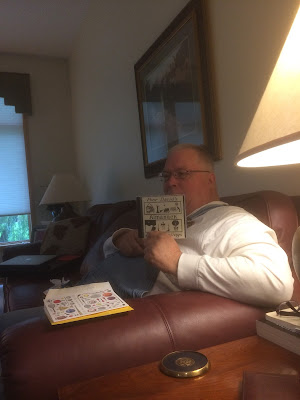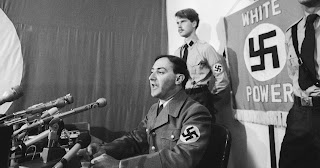'Swastika war': When the neo-Nazis fought in court to march in Skokie
Excerpt:
Four decades ago, a neo-Nazi group announced plans to march in Skokie, home to thousands of Holocaust survivors. The news set off a rhetorical firestorm that the Chicago Tribune dubbed the "Skokie swastika war."
In 1977, the swastika became the centerpiece of a constitutional question posed by a small group of neo-Nazis who called themselves "National Socialists" — a callback to the formal name of Adolf Hitler's political party. When the group encountered pushback over its plans to march through Skokie that spring while carrying flags bearing the swastika, its leader, Frank Collin, invoked the First Amendment as his defense.
Skokie, Nazis and the First Amendment: Freedom of Speech on trial - Confederate Flags and Swastikas are uncomfortable, but still protected under the Constitution.
Excerpt:
The National Socialist Party of America, neo-Nazis, wanted to march in Skokie on May 1, 1977. They asked Skokie officials for permission to stage a rally in front of the village hall to protest a local ordinance. The group planned to wear Nazi uniforms with swastika emblems and armbands. It also promised to demonstrate peacefully and to obey reasonable police instructions or requests.
While most Americans believe in the First Amendment, most also would not want this group to march where they live and work. In Skokie, this was especially true, as most of its residents were Jewish. Thousands of Skokie residents survived concentration camps and the Holocaust and believed they were safe from the influence of Adolf Hitler here in the United States
Not surprisingly, a firestorm of controversy erupted. The Nazis took the case to court. The trial court disallowed the march, and then the Illinois appellate court upheld the ban after refusing to look at the case. The Illinois Supreme Court then refused to grant review of the case or to stay the injunction, effectively denying the Nazis their rights to free speech and assembly.
Lawyers from the American Civil Liberties Union defended the Nazi request. The ACLU asserted that they were not defending Nazi idealism but the freedom of speech. Attorney David Goldberger, a Jew, stated:
“Your Honor, if this court issues a preliminary injunction in the case, enjoining the demonstration of Mr. Collin and the National Socialist Party of America, I fear that the Village of Skokie will be dancing in the grave of the First Amendment.”
The Illinois Supreme Court denied a stay of injunction. The Nazis then took the case to the United States Supreme Court.
The Village of Skokie argued that neo-Nazi speech promoted racial or religious hatred and is unprotected by the First Amendment. The courts rejected this argument on the grounds that it is not a reason for suppressing speech alone. As long as they are not burning down houses, inflicting bodily harm or destroying property, they have a right to express what they want. Why? If the Supreme Court silenced one group, it effectively silences all groups since all Americans have the same rights under the Constitution – even groups that are offensive to mainstream America.
The village also claimed that the purpose of the marches was to inflict emotional harm on the Jewish residents of Skokie. However, the Nazis originally petitioned to march in a different town with a minute Jewish population. Denied that permit, they decided to march in Skokie so they would get publicity for their grievance. Then, when faced with having to pay $350,000 to cover insurance for that march, they became more resolute.
In addition, Skokie mayor Albert Smith testified that, if the Nazis marched, there would be uncontrollable violence as a result. But once a government gives in to such threats of violence, it effectively empowers any group of people who wants to silence others to do so simply by threatening to violate the law.
In the end, the Supreme Court ordered the Illinois Supreme Court to respond. It finally struck down the injunction against the Nazis in January 1978, paving the way for a Nazi demonstration. Fortunately, they declined to march in Skokie and marched somewhere else.
The Village of Skokie had also passed three new ordinances. The first required that a permit would be necessary for any demonstration. Next, political organizations could not demonstrate in military style uniforms. The third ordinance banned the display of symbols offensive to the community.
The Supreme Court, which included Justice Thurgood Marshall, the first black American Supreme Court Justice found the ordinances to be unconstitutional.
I [the author of this article] was 13 when this happened. During this time, the Nazis staged a march at Veterans Memorial Park in South Holland, Ill., not far from where my family lived. My girlfriends and I told my mom we wanted to go throw rocks and eggs at them. My mother, in her wisdom, instead of saying no, explained that if we did that we would be giving the Nazis what they wanted — publicity. Good or bad publicity put them in the public eye — right where they wanted to be. And they were willing to endure rocks, eggs and other items thrown at them if necessary.
We decided that the Nazis were not worth our time and effort. The best way to deal with groups like this is to not give them an audience. And we didn’t.
The Supreme Court Case:
National Socialist Party of America v. Village of Skokie
In a per curiam opinion, the Court held that Illinois must provide strict procedural safeguards, including appellate review, to deny a stay for an injunction depriving the Nazi Party of protected First Amendment rights. The Court treated the Illinois Supreme Court's denial of a stay as a final judgment for the purposes of Supreme Court jurisdiction because it involved a right separable from and collateral to the merits of the Nazi Party's case. Hence, the Court also treated the Nazi Party's application for a stay as a petition for certiorari. The Court reversed and remanded the case for further proceedings.
Comments: There are groups that I find absolutely repugnant:
The second thing the president did that was worthy was that he denounced the criminals and thugs on both sides. This is what you want from magistrates. If the white supremacists get a permit, and they are marching to Hell in an orderly fashion, they ought to be allowed to march there unmolested. If antifa thugs show up with baseball bats and attack, they ought to be treated as the violent instigators they are. If one of the white supremacists drives his car into the crowd on the other side, that is not self-defense, and he needs to be prosecuted to the fullest extent of the law. Policemen, and the magistrates behind them, are in the business of maintaining public order, which means that they do not get to approve of anarchy from one side only.
If there is outrage over Trump’s denunciation of both sides, then it is plain and obvious that someone is attempting to steer us. In response to my post yesterday, someone breathlessly announced that I had equated Black Lives Matter with the Klan. Why, yes, I did. Hatred and murder are to be reprobated, period. Movements that excuse them are to be reprobated, period. But when your moral compass is governed by the skin tone of your tribe, instead of letters in granite inscribed by the finger of God, then you are going to get the kind of identity race war that we are in the process of getting.
I wasn't aware of 1969 SCOTUS case


















































